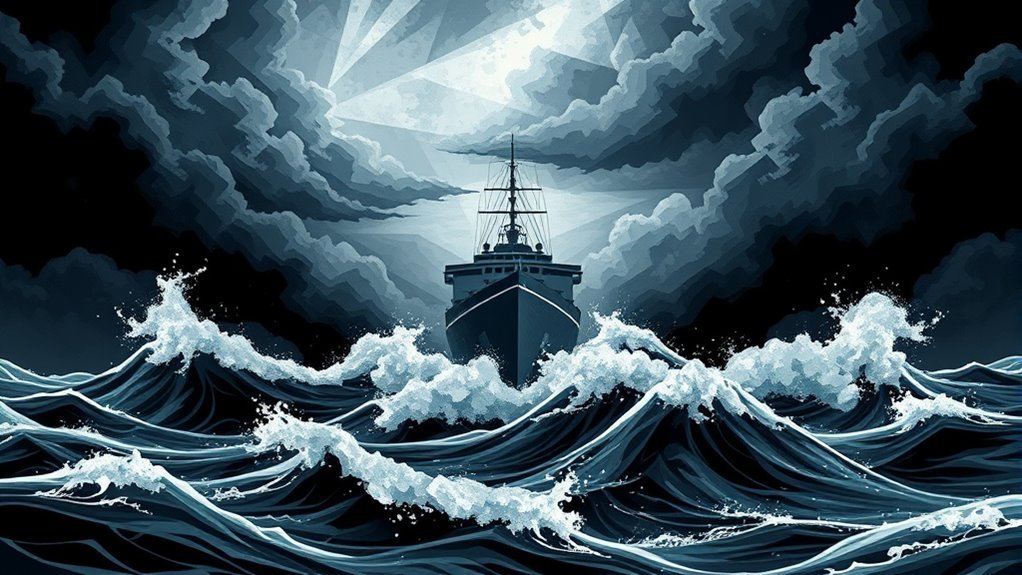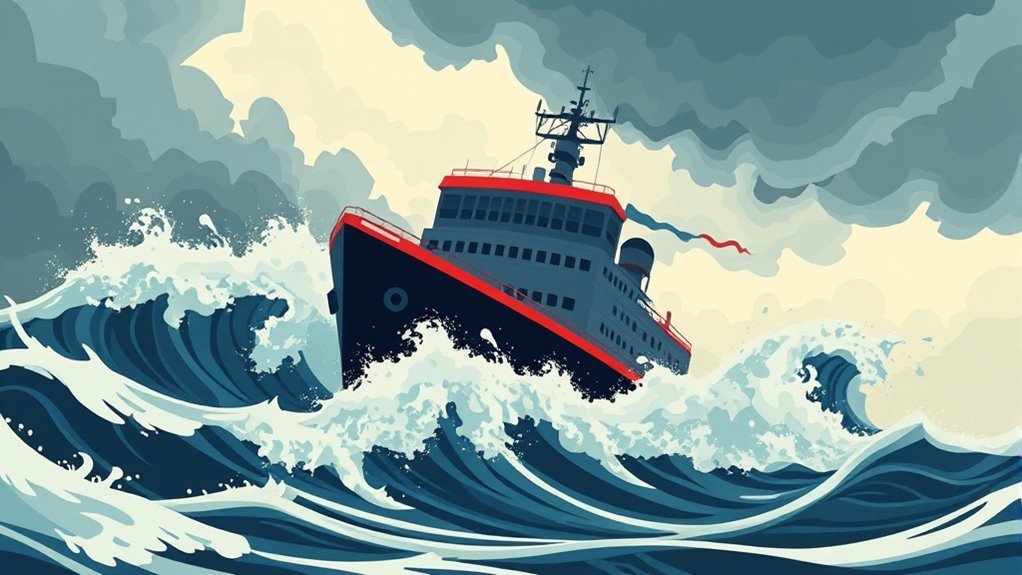Sudden squalls at sea are intense, brief storms that emerge unexpectedly, marked by rapid wind changes and heavy rain. They greatly impact navigation, as they can cause loss of control, reduced visibility, and dangerous waves. Sailors must identify early signs, such as darkening clouds and shifting winds, to avoid hazardous conditions. Implementing safety protocols and monitoring weather can improve preparedness. Exploring further reveals effective strategies and essential gear to better handle these unpredictable maritime challenges.
Main Points
- Sudden squalls can create hazardous conditions at sea, characterized by rapid wind changes and intense rain, impacting navigation and vessel stability.
- These storms often develop unexpectedly due to temperature gradients, topographical influences, or colliding air masses, posing significant risks to ocean travel.
- Sailors face challenges such as reduced visibility, turbulent waves, and the need for immediate course adjustments during sudden squalls.
- Essential navigational strategies include monitoring weather forecasts, utilizing radar systems, and staying vigilant for visual cues of approaching squalls.
- Preparedness measures, like equipping vessels with safety gear and conducting emergency drills, are crucial for minimizing risks during unexpected squall events.
Understanding Sudden Squalls: Definition and Characteristics
Sudden squalls are intense, brief storms that can arise unexpectedly at sea, defined by rapid changes in wind speed and direction. These phenomena can develop swiftly, often within minutes, creating hazardous conditions for vessels.
Distinguished by sharp increases in wind intensity, squalls can produce gusts that double or even triple baseline wind speeds. Accompanying these winds are adverse weather conditions, including heavy rain or hail, which can severely reduce visibility and complicate navigation.
Typically lasting only a short time, squalls can generate steep waves and turbulent seas, posing considerable risks to mariners. Their unpredictable nature makes them particularly dangerous, as sailors may not have adequate time to prepare or respond effectively.
Understanding the traits of sudden squalls is essential for ensuring maritime safety, emphasizing the need for vigilant weather monitoring and readiness to adjust to rapidly changing sea conditions.
Common Causes of Sudden Squalls at Sea

Understanding the origins of sudden squalls is essential for mariners seeking to steer safely through unpredictable waters. These intense and brief weather events can arise from various atmospheric conditions, often surprising those at sea.
Common causes include:
- Temperature gradients: Rapid changes in air temperature can create instability.
- Topographical influences: Nearby landforms can disrupt wind patterns, leading to sudden gusts.
- Cold fronts: The collision of warm and cold air masses typically triggers squall formation.
- Sea breezes: Daily temperature variations can generate localized wind shifts, resulting in sudden squalls.
- Tropical storms: The remnants of these larger systems can create severe squall lines even at a distance.
Understanding these factors allows mariners to better prepare for the unpredictable nature of sudden squalls, enhancing safety and navigation on the open sea.
Recognizing the Signs of an Approaching Squall
How can mariners effectively identify the signs of an approaching squall? Recognizing the early indicators is essential for ensuring safety at sea.
One prominent sign is a sudden shift in wind direction, often accompanied by an increase in wind speed. Mariners should also pay attention to darkening clouds, particularly the development of towering cumulus or cumulonimbus formations, which signal potential instability in the atmosphere.
A noticeable drop in temperature can occur, indicating an impending squall. Additionally, the sea surface may exhibit unusual behavior, such as increased wave height or choppy waters.
Observing changes in visibility, such as reduced clarity due to rain or mist, further suggests a squall's approach. Finally, the presence of birds or marine life behaving unusually can serve as additional warnings.
The Impact of Sudden Squalls on Vessel Navigation

Sudden squalls present substantial navigation challenges for vessels, often resulting in abrupt changes in wind and sea conditions.
To guarantee safety, crews must implement established protocols while also relying on advancing weather prediction technology to anticipate these rapid shifts.
Understanding the interplay between these factors is essential for effective maritime navigation during such unpredictable events.
Navigation Challenges Faced
When unexpected squalls strike at sea, they pose substantial navigation challenges for vessels caught in their path. The sudden shifts in wind and water conditions can disorient even the most experienced mariners.
Vessels may find themselves grappling with:
- Rapidly changing wind directions, causing loss of control
- Intense rain reducing visibility to mere feet
- Turbulent waves that threaten stability and steering
- Debris and flotsam creating unexpected hazards
- The urgent need to adjust course to avoid capsizing
These factors combine to create a dangerous environment, where quick decision-making is essential.
Navigators must rely on their skills, technology, and instinct to guide their vessels safely through the chaos, emphasizing the unpredictable nature of ocean travel during squalls.
Safety Protocols for Vessels
Effective safety protocols are essential for vessels maneuvering the unpredictable conditions brought on by sudden squalls. These protocols typically include maintaining a vigilant lookout and regular communication among crew members to guarantee swift responses to changing weather.
Implementing an extensive pre-departure safety briefing equips the crew with the knowledge to handle unexpected turbulence. Additionally, vessels should be equipped with reliable navigation and safety gear, such as life jackets, flares, and emergency beacons.
When a squall is detected, immediate action should be taken, including adjusting sails, reducing speed, and seeking safe harbor if necessary. Regular drills and training sessions improve crew readiness, making certain that every member knows their role during crises.
In the end, thorough safety protocols considerably reduce risks associated with sudden squalls at sea.
Weather Prediction Technology
Although unpredictable by nature, sudden squalls can be anticipated to some extent through advancements in weather prediction technology.
These tools have markedly improved vessel navigation, allowing for better preparedness against the dangers of unexpected storms.
Key technologies include:
- Satellites: Providing real-time data on atmospheric conditions.
- Doppler Radar: Tracking precipitation and wind patterns with precision.
- Buoy Systems: Monitoring sea temperature and wave activity.
- Numerical Weather Models: Simulating future weather scenarios based on current data.
- Mobile Apps: Offering instant updates to sailors in remote areas.
Safety Protocols for Sailors During Squalls

Sailors must prioritize safety by implementing effective protocols when faced with sudden squalls.
Pre-emptive weather monitoring is vital for anticipating these storms, while emergency maneuver techniques can greatly improve vessel control during turbulent conditions.
Understanding these strategies is imperative for minimizing risks and ensuring the safety of all on board.
Pre-emptive Weather Monitoring
A proactive approach to weather monitoring can greatly improve safety for those traversing the open seas.
Sailors equipped with reliable forecasting tools can anticipate squalls before they strike. This foresight allows them to take necessary precautions, reducing the potential for danger.
Effective monitoring includes several key practices:
- Utilizing satellite-based weather services for real-time updates
- Regularly checking barometric pressure changes
- Listening for maritime weather advisories
- Employing radar systems to detect incoming storm cells
- Maintaining communication with coastal weather stations
Emergency Maneuver Techniques
When squalls suddenly appear on the horizon, swift and decisive action becomes imperative for maneuvering safely through turbulent waters.
Sailors must first reduce sail area to minimize heeling and maintain control. Lowering the mainsail and reefing the jib are essential steps to stabilize the vessel.
Next, they should steer directly into the wind, allowing the boat to ride the waves more effectively, thereby reducing the risk of capsizing.
It is critical to secure all loose items on deck to prevent hazards. Communication among the crew is imperative; assigning clear roles guarantees efficient responses.
Finally, once the squall passes, sailors should assess the situation, checking for damage and preparing for any subsequent weather changes.
These techniques improve safety during unpredictable conditions.
Navigational Strategies to Avoid Sudden Squalls
Although sudden squalls can strike unexpectedly, effective navigational strategies can considerably reduce the risks they pose. Mariners can employ several techniques to improve their safety and avoid these sudden weather changes.
- Regularly monitor weather forecasts to stay ahead of potential squalls.
- Utilize radar systems to detect storm formations and gauge their proximity.
- Adjust course proactively, steering away from areas with rapid wind changes.
- Maintain a keen lookout for visual cues, such as darkening skies and shifting winds.
- Communicate with other vessels to share real-time information on weather conditions.
Preparing for Sudden Squalls: Essential Gear and Equipment
Preparation plays an essential role in steering through sudden squalls. Mariners must equip their vessels with essential gear to guarantee safety and efficiency during unexpected weather changes. A reliable weather radar and satellite communication system are critical for real-time updates on changing conditions.
Additionally, a well-stocked emergency kit, including flares, a first aid kit, and signaling instruments, is crucial for quick response in emergencies. Properly secured life jackets for all passengers and crew improve safety, while non-slip footwear helps maintain stability on deck.
Moreover, keeping essential tools, such as a hand-held compass and a sturdy flashlight, readily available can aid in direction and visibility during squalls. Lastly, securing sails and rigging in advance minimizes damage and secures the vessel's readiness to adjust quickly.
Common Questions
How Do Sudden Squalls Differ From Regular Storms?
Sudden squalls are brief, intense bursts of wind and rain, differing from regular storms, which are typically more prolonged and predictable. Squalls can develop rapidly, creating hazardous conditions that challenge preparedness and response efforts.
What Types of Vessels Are Most Affected by Squalls?
Certain types of vessels, particularly smaller boats and those with less stability, are most affected by squalls. Their design limits resistance to rapid wind changes, making them vulnerable to sudden and intense weather conditions.
Can Squalls Cause Damage to Marine Infrastructure?
Squalls can indeed cause considerable damage to marine infrastructure. Their intense winds and sudden changes in weather can lead to structural failures, compromising docks, piers, and other facilities, eventually impacting safety and operational efficiency.
What Role Do Meteorologists Play in Squall Prediction?
Meteorologists analyze atmospheric conditions and utilize advanced technology to predict squalls. Their proficiency in interpreting data helps in forecasting sudden weather changes, allowing for timely warnings and preparations to mitigate potential hazards associated with these unpredictable events.
Are There Specific Regions Where Squalls Are More Common?
Certain regions, particularly tropical and temperate zones, experience more frequent squalls due to atmospheric instability. Coastal areas and locations near large bodies of water also see heightened squall activity, influenced by local weather patterns and topography.

